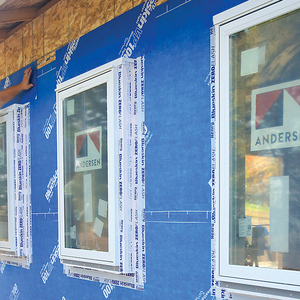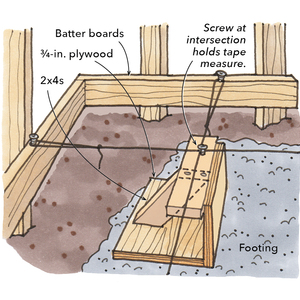I am looking for the follwoing information concerning in ground Geothermal heat pumps.
What is the relationship betweeen the size of the house and the area required to install a horizontal bed ( how deep?)
The ballpark price of installing a system?
The overall benifits of the system.
Thank you in advance
George



















Replies
My HVAC guy said 5' deep, so we dug 7' to reach the water table. 3 ton system w/electric coil backup took 3 lines 125' long each (or was it 150'?) We curved them around the yard and it didn't take much room. Carrier brand unit installed, lines filled, return plenum installed, everything tested etc (I did the my own main ducts and the excavation) for $7,000
I had estimates as high as $18K
The system was great, we had a large house but could keep the breaker to the backup heat off most of the winter. The electric bill was pretty reasonable.
The only problems were the unit was a little louder than I wanted indoors at night, and the line pressure dropped slightly, making me paranoid I had a leak. The guy came back and pressured it back up w/my garden hose - no sweat.
In my new house the strategy is super-insulation, so ground source would yield diminished returns, but I'd do it again otherwise.
I did a five ton unit and did the slinky coils one coil per ton each was 600 feet long, but needed 5' by 80' of space. I was told to put them 5' deep so I put then 7' to 8'. I did the coils and excavation myself. I did all of the radiant floor heating and fan coil instillation myself (no backup). So for design, parts and tech help I paid 13,000, but I also had high tech controls with an outdoor censor that builds a heating curve that makes it exponentially more efficient. I also did super installation. I also put an electric meter on the heat pump so I can see how much power I use, so I will know more next spring.
wyatt
Wyatt - what type of electric meter did you use? I am looking for a product to meter the apartment above my garage.
Wyatt
Thank you for your response by the way I would like to put the system in Toronto Ontario.
- "Radiant floor heating and fan for coil installation" Could you give me a quick explaination as to how you transfer the ground temp. in the ground lines to the higher temp in the radiant floor heating. Also is the radiant floor heat the only source of heat for the house.
-How does the out door censor help the system to be more efficent.
-How do you back fill the aea around the underground piping. with what material.
Did you install this in a new house or retro fit a older house.
Thank you again
George
- "Radiant floor heating and fan for coil installation" Could you give me a quick explanation as to how you transfer the ground temp. in the ground lines to the higher temp in the radiant floor heating.
GROUND SOURCE HEAT PUMP
Also is the radiant floor heat the only source of heat for the house.
YES
-How does the out door censor help the system to be more efficient.
I HAVE AN AQUASTAT WITH AN OUTDOOR CENSER THAT MAKES A HEATING CURVE TO CHANGE THE TEMP OF THE WATER IN THE RADIANT SYSTEM
-How do you back fill the area around the underground piping. with what material.
I COVERED WITH SAND AND THEN WITH THE EXCAVATED MATERIAL
Did you install this in a new house or retro fit a older house.
NEW HOUSE
WYATT
If you have a true Geothermal situation, then you would be using a fairly small patch to transfer heat from the magma under your land and you probably wouldn't even need a heat pump. While many people call what you are describing as "Geothermal", I prefer the term "ground source" while reserving "geothermal" to mean the type of systems they have in Iceland and at the Geysers where they tap fairly high temperatures from volcanically active areas. I see that what was once the "Geothermal Heat Pump Consortium" now refers to the process as "geoexchange".
There are a large number of websites dealing with ground source heat pump parameters and doing a search should give you more reading than you would ever care to do.
Speaking as a hydrogeologist, what you're referring to is a hydrogeothermal system. Geothermal simply means "earth heat".
Jo
Yeah, I am aware of the derivation of the term Geothermal. Most definitions I have seen refer to heat eminating from the interior of the earth and many of them make reference to fairly high temperatures. When I was involved in alternative energy studies at UC Berkeley in the early 1970s, the term geothermal was generally reserved for situations where the heat energy extracted from the ground was at or above the required temperature for the end process, unlike ground source heat pumps where the extracted thermal energy requires that the temperature be "amplified" or boosted through the use of the heat engine. Geothermal, as a term, was generally used to refer to thermal energy derived from geothermal reservoirs in which steam or superheated water was used to power turbines or other devices or was used for heating homes such as in Iceland.
Until I just did an Internet search, I had not heard the term "hydrogeothermal" used as the term describing the process of extracting high temperature thermal energy, only in conjunction with the description of natural systems such as hot springs and geysers. While I did find the term used a couple of times to describe thermal energy extraction for human use, it does appear to be a fairly rare use.
And I realize that this is nit-picking and that the 1970s were long ago and far away and never to return (darn it) and that English is a living language with a proclivity to transmorgify any useful term. After all, it was not too many years ago that "cool rod" was a thermally challenged enlongated solid cylinder while a "hot chick" was a recently hatched chicken with an elevated temperature...
My main point was intended to be that many, if not most, individuals involved with the process he was describing used the term "ground source heat pump" and he would likely find additional useful information if he did an Internet search on that topic. Anyway, thanks for expanding my geological terminology.
I'm mainly familiar with the academic meaning, not the "energy extracting" terminology. It's funny how much meanings differ between different industries/groups.In grad school I specialized in geomicrobiology and biogeochemistry (my research was concerning microbes eating oil in contaminated groundwater)--there is a pretty endless supply of complicated words to describe the natural world. Jo
Agree with you totally Casey - the marketing weenies have corrupted precise technical terminology. I did some true hot well geothermal work in Nevada in the early 1980's, and the true geologists working the program (who had done wells in CA, Klamath Falls, and Rotarua sp.) only put the term "geothermal" on water (either natural brine or recovered injected water into hot dry holes) that was in excess of 65C (149F).
FWIW, whenever I hear (or read) somebody (even a 'hydrogeologist') describe a GSHP system as geothermal, it defines someone who was educated? in a dumbed down system and also as someone likely to feed me a line of marketing bull$$ and has never bothered to learn correct terminology.
If David Thomas reads this thread, would like to get his take on GSHP vs geothermal terminology - if he says the technical part of the industry truly uses the terms interchangeably, I'll accept that.
Some general information:
http://www.eere.energy.gov/consumerinfo/factsheets/geo_heatpumps.html
http://www.eere.energy.gov/consumerinfo/factsheets/ghp_homeowners.html
This one is a PDF, so might take a min or so to load,
http://www.ornl.gov/sci/femp/pdfs/gshp-pro-chal.pdf
Sorry I don't have any overall pricing info for you. Down the road I hope to make use of a geothermal heat pump, but will probably utilize a vertical loop so that it requires less yard-space.
jt8
"Striving for excellence motivates you; striving for perfection is demoralizing." --Harriet Braiker
Just a note on the yard space - we use the yard like any other area - its just grass, no one could ever tell there were lines. Unless you are in the city, trenches are usually the cheaper option, although wells give a cleaner (to the yard) installation.
I used stone dust to back fill instead of sand, it was cheaper locally. One load did it.
The geothermal heatpump is like a regular heatpump, in that it "amplifies" the heat through the compression/decompression of refrigerant. You simply use 58 degree ground instead of variable ambient air temperatures to get it done, hence the efficiencies.
Geothermal and ground source heat pump mean the same thing to everyone I talk with. Maybe some day I'll drill to the moho and pump magma.